Currently, humans generate over 1,400 tons of carbon every single minute. Leading scientists have posited that the escalation in carbon emissions contributes to an uncontrollable greenhouse effect, which in turn, results in global warming.
To combat this, we can plant trees that trap and store Co2 from the atmosphere. Some trees do it better than others. Some of the best trees to offset your carbon footprint are:
- Silver maple
- Red mulberry
- Ginkgo biloba
- Eucalyptus
- European beech
- London plane
- Pine trees
But how much carbon can they store and will they offset your footprint? Let’s find out.
What we cover
ToggleWhat is carbon sequestration?
Carbon-based living forms include all plants and animals on the planet. We all require carbon to live.
However, human activity accounts for the majority of carbon emissions, and humans have a key influence on carbon emissions.
According to studies, humanity has released over 1.5 trillion tonnes of CO2 into the atmosphere since the Industrial Revolution, and we are still pumping out roughly 1.3 billion tonnes in the year 20191.
However, some scientists are working to bring carbon dioxide atmospheric levels down. One solution for this is called “terrestrial sequestration,” which involves planting trees. The trees then absorb carbon dioxide through a chemical process called photosynthesis.
How does carbon sequestration work?
This process uses energy from sunlight to convert water and Co2 into oxygen and energy-storing carbohydrates.
Plants and trees consume these carbohydrates in a reverse process called respiration and converting them into energy and releasing carbon back into the atmosphere.
In their life cycle, the carbon is stored within the tree’s wood, and during their lifetime the tree acts as a carbon vault, acting as a trap for the gas. In essence, the tree has “sequestered2” carbon dioxide.
So if trees are going to help fight a long-term problem like climate change they need to survive to sequester carbon for the longest period possible.
Which trees should you plant to reduce carbon?
There’s no universal answer to this and no single tree that’s best at it. Pines, oaks, and many other trees are known to absorb a lot of carbon. Even though all trees use carbon dioxide, some are more effective, and some are not.
However, we have compiled a list of the best trees that you should consider planting.
American Sweetgum tree
American Sweetgum also called Liquidambar or redgum is a fast-growing deciduous tree found mainly in the parts of southeastern United States.
The American Sweetgum tree stores up to 380 pounds of CO2 every year.
As it is a deciduous tree it seasonally sheds its leaves. One interesting feature this tree has is that it has star-shaped leaves which turn from green in summer to yellow or purple in autumn.
Sweet gums are best cultivated in a big garden because they can grow 80 – 120 feet tall and 8 meters wide. They also need a lot of space for their root development. However, there are more slender and compact kinds available.
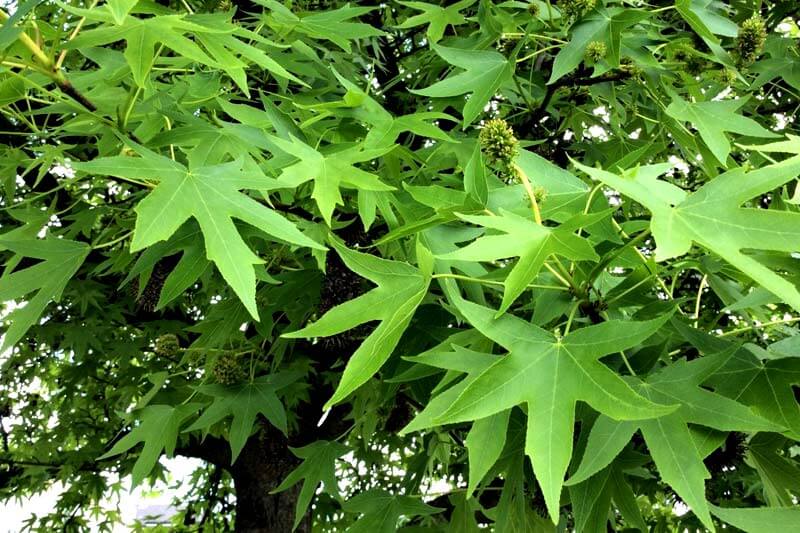
Eucalyptus tree
The Eucalyptus tree has a major impact on livelihood generation and carbon sequestration. Its wood is thick, which means that each cubic inch of wood retains more carbon; it grows swiftly and absorbs carbon quickly. It’s also not a water guzzler.
Eucalyptus trees can store up to 70 pounds of CO2 per year.
When compared to other tree species, a Eucalyptus plantation uses 785 litres per kilogramme of total biomass, which is one of the lowest.
The root system of most eucalyptus species has a root depth of 1.5-2.0 metres, and it is more particularly adapted to use rain-fed soil moisture from the upper soil profile rather than groundwater from a depth of several metres.
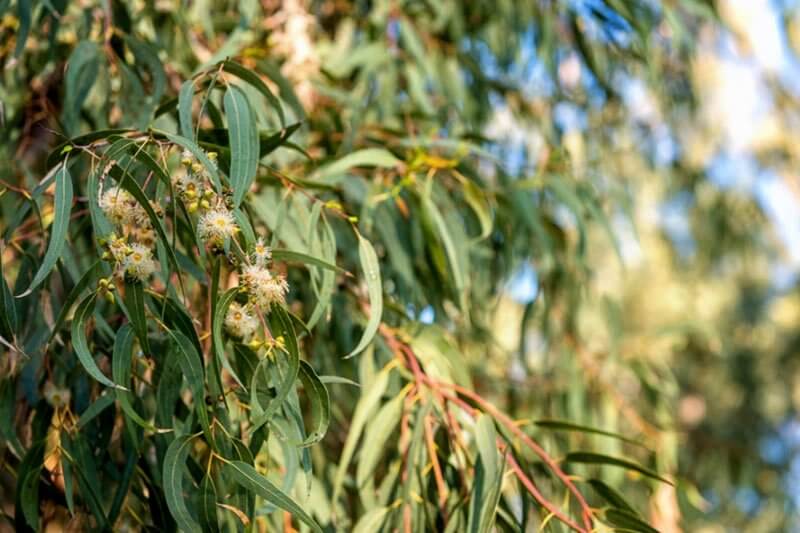
European Beech
European beech trees are great for filling in huge areas and serving as a focal point in the landscape.
These trees grow slowly, growing 1 to 2 feet each year on average. However, they live incredibly long lives, typically reaching 200 years old or even more.
As a result, it has 112 pounds of storage capacity of CO2 per year.
The European Beech has an upright oval to rounded shape that grows quite large. The trunk is small, and the limbs begin low on the tree. European beech trees are known for their smooth, thin, silvery-grey bark. The dark green leaves grow to about 4 inches long and become a stunning golden bronze color in the fall. Small yellow-green flowers blossom in the spring and give place to seeds, or beechnuts.
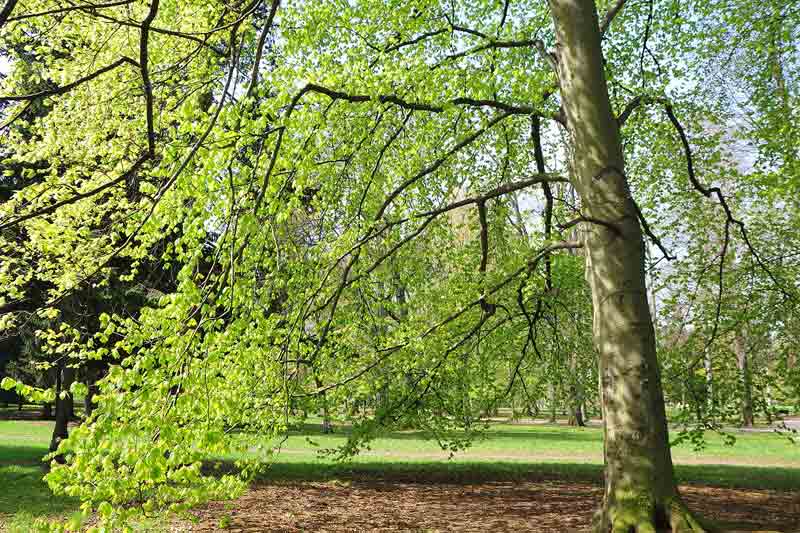
Laurel Oak Tree
The Laurel Oak tree is also known as Quercus laurifolia and the ornamental value of this semi-evergreen tree comes from its pleasant appearance.
Its pest-resistant quality adapts well to a variety of soil types, making it a popular choice for many. Laurel oaks are higher than they are wide, eventually reaching a height of 60 feet or more with a 35- to 45-foot spread.
Laurel Oak trees have a storage capacity of 70 pounds of CO2 per year.
If planted in tree lawns smaller than eight feet wide, the trunk can grow up to four feet in diameter and flare out at the base, raising sidewalks and curbing.
In the north of the USA, trees are deciduous, whereas, in the south, they are semi-evergreen. The spherical acorns and the smooth, slender leaves are both glossy on both sides.
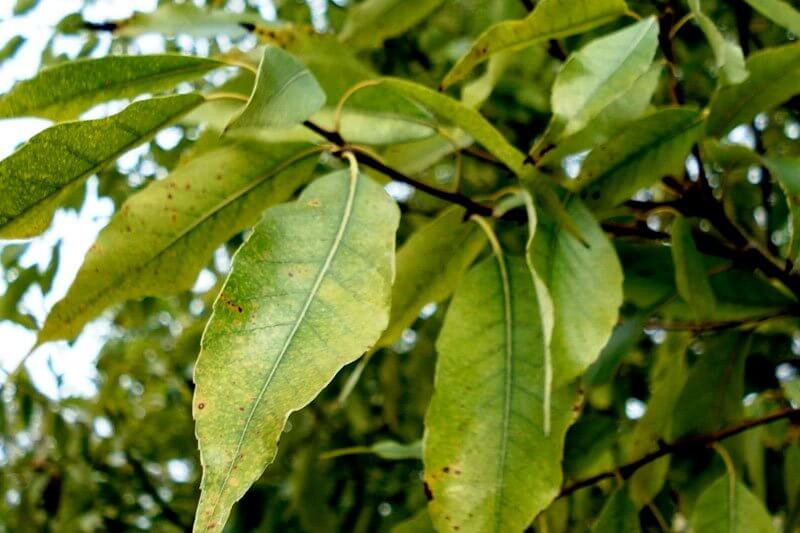
London Plane Tree
The London plane (Platanus x acerifolia) is a hybrid sycamore that was created by crossing American and Oriental sycamores. It is an essential landscape tree due to its disease tolerance quality and ability to develop quickly in urban soils.
This tree is often planted as a street tree in large cities because of its capacity to adapt to urban settings and resistance to pollution.
It has the capacity to store up to 50 pounds of CO2 per year.
The London plane tree has star-shaped leaves that are a pleasant welcome to the warm season, attracting beautiful butterflies and bees, and the blossoms fall to the ground like a stunning golden rain shower.
Despite its reputation as a survivor, this tree is worth admiring. The unique bark and fascinating branching lend it tremendous visual appeal in both summer and winter.
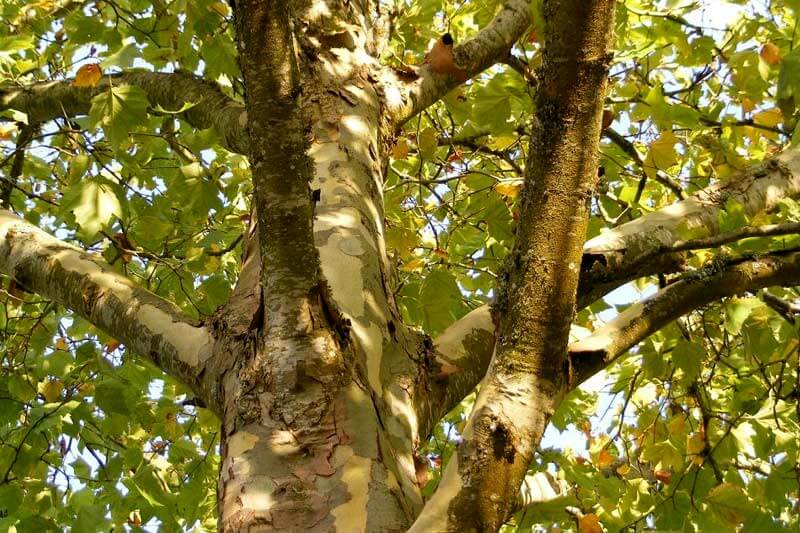
Red Mulberry Tree
The Red mulberry tree, also known as the Morus rubra, is a medium-sized deciduous tree that may grow to 30 feet tall.
This tree has the capacity to store 70 pounds of Co2 per year.
It is widespread in the Eastern United States. The leaves are heart-shaped, thin, toothed, and usually dark green ranging from 3 to 5 inches long. Those dark green leaves turn a golden yellow into autumn.
Mulberry trees require well-drained soil for their roots to obtain adequate oxygen. So a place that is exposed to direct sunlight is suitable for them to grow.
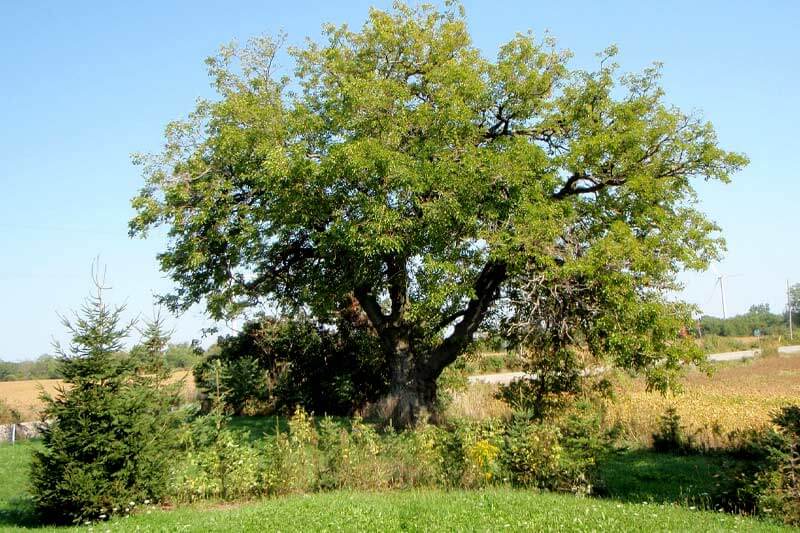
Silver Maple Tree
Silver maple leaves are dark green on top and silvery below. The silver maple seed that descends like a helicopter in late spring is one of the most common characteristics.
This tree grows to be 50 to 80 feet tall, with a spread of up to 50 feet.
Other characteristics of the tree include:
- Rapidly expanding.
- Green on top and silvery-white underneath, the leaves shimmer and dance in the breeze.
- Tolerates a broad variety of soil types.
Be sure to plant 10 feet or more away from sidewalks, roads, foundations, and sewage lines due to a strong root system.
Full sun and partial shade are best for this tree, meaning it prefers a minimum of four hours of direct, unfiltered sunlight each day.
Squirrels nibble the silver maple buds in the early spring. It also serves as the breeding ground for ducks and other birds. It is also tasty food for the beavers.
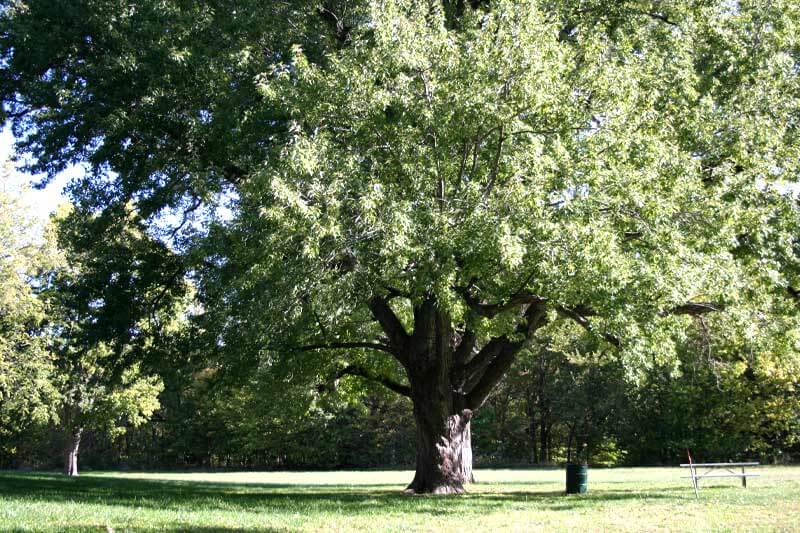
Ginkgo biloba
Ginkgo biloba or simply ginkgo, also known as the maidenhair tree, is a large broadleaf, deciduous tree with a sculptural pyramid shape. This tree in ancient times was classified as conifer and dioecious because some trees were male while others were female.
This tree can absorb about 60 pounds of CO2 per year, making it an essential addition to the environment.
It has unique fan-shaped green leaves but changes to golden-yellow in the fall. It loses its leaves in winter and can grow both in acidic and alkaline soil but prefers well-drained sandy soil or loam with a pH in the 5.0 to 8.0 range.
Ginkgo trees are commonly grown in urban sites but can struggle in hot and dry climates.
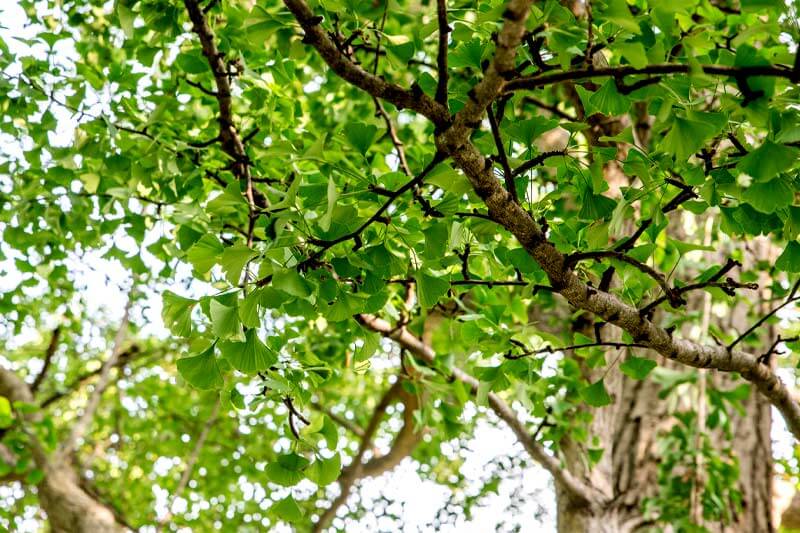
Some practical advice when planting these trees:
Allow plenty of room
Determine the size of your tree when it reaches maturity and prepare accordingly.
Keep in mind that roots can extend far further than branches, causing damage to sidewalks and even house foundations. You may be liable for damages if you do not call local utility companies to discover subterranean pipelines and cables.
Minimize fertilizers
Many of the most effective carbon offset trees thrive in poor soil. Commercial fertilizers used directly in the planting hole might harm the roots and release harmful nitrous oxide, which can cancel out the tree’s carbon benefits. Your own kitchen compost is the finest low-impact soil amendment.
Plant local trees
There are some disadvantages to planting trees to absorb Co2 from the atmosphere. If you plant the wrong trees it can upset the local ecosystem and local trees could struggle. Also, be diverse in the trees you plant and keep densities similar to what they currently are.
Where trees are most needed?
Urban cities
Due to the scorching heat of the sun, all the urban cities are becoming heat islands. The vast stretches of asphalt elevate and reflect the Sun, sending CO2 directly and creating a “dead zone”. In such places, the tree is like life. A tree offers shade, provides habitat for wildlife, and improves air quality. Summer heat can be lowered by adding street trees.
Tropical region
According to carbon offset research, the equatorial areas’ prolonged growing season and fertile soil enable trees to multiply their carbon storage capability. But in the recent decade, forests have been damaged by industrial development and are in desperate need of restoration.
- Hannah Ritchie, Pablo Rosado and Max Roser, (2023) CO₂ and Greenhouse Gas Emissions. <https://ourworldindata.org/co2-and-greenhouse-gas-emissions> Accessed: 06-03-2024
- Francisco Escobedo, Jennifer A. Seitz, and Wayne Zipperer, (2022) Carbon Sequestered By An Urban Forest. <https://edis.ifas.ufl.edu/publication/FR272> Accessed: 06-03-2024



